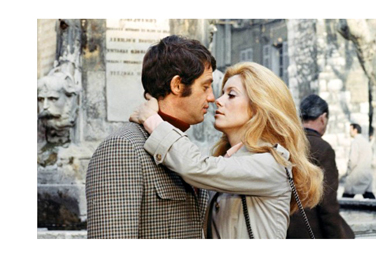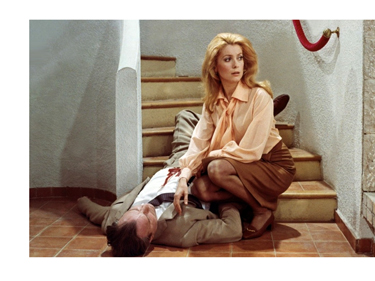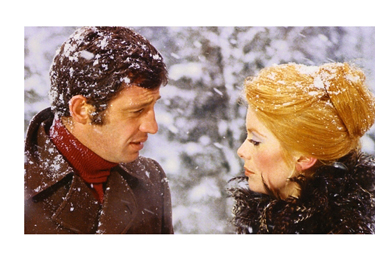
 |
|
|
|
Of all the official New Wave directors, François Truffaut was the least radical. Rather than trot out new theories of film to confound his audience, he simply brought a looser, less formal technique to increasingly conventional dramas. Jules & Jim is like a poet's sketchbook, a hit & miss affair connecting brilliant bits of spontaneity with long sequences nailed down by old-fashioned voiceovers. The director's relaxed manner with actors made his early films seem improvised, as if his camera had just managed to capture the events we see. Truffaut went more mechanical for two or three films while on his Hitchcock kick in the middle '60s. Of his two 'Hitchcockian' Cornell Woolrich adaptations, The Bride Wore Black is a very successful, if formally dry, storyboard construction. But his 1969 Mississippi Mermaid tries to have it both ways. The story is a rigid noir of betrayal and amour fou; Truffaut's execution leans back toward the 'let's just observe the behaviors' quality that serves him well. When United Artists imported the picture they cut 13 minutes out of it and messed up the title as well. "Mississippi" is the name of a boat. The original La Sirène du Mississippi conjures up the appropriate image of a Siren, a femme fatale. 'Mississippi Mermaid' sounds like a Burt Reynolds movie, something set down in the mud marshes. 
Sprawling across the screen in wide Dyaliscope 1 , Mississippi Mermaid recounts the fated collision of French colonial tobacco planter Louis Mahé (Jean-Paul Belmondo) and Julie Roussel (Catherine Deneuve), his mail order bride who came 7,000 miles to the Indian Ocean to meet him. Julie looks nothing like her photo -- actually better than her photo. In their letters she hid her beauty and he his wealth as a test of sincerity. All is glorious until Julie disappears, taking with her the bulk of Louis' fortune. Not only that, Berthe Roussel (Nelly Borgeaud), arrives to find out what happened to her missing sister Julie. Infuriated, Louis hires the dogged detective Comolli (Michel Bouquet of The Bride Wore Black to track 'Julie' down, and himself returns to France. By the wildest chance he finds Julie working as a club hostess. Her real name is Marion Vergano. She claims that she was the pawn of someone named Robert, a man that pushed Julie Roussel overboard on the sea voyage. Louis finds himself unable to kill Marion. Beyond all logic and wisdom, he instead abandons his entire life to join her on the run from the authorities. And not soon after, he becomes a murderer as well. The only question is, is the cool customer Marion capable of reciprocating Louis' absolute love? Truffaut begins Mississippi Mermaid with a sequence demonstrating where the island of Reunion is, as even the average Frenchman probably doesn't know. The prologue comes with a sequence from Jean Renoir's La Marseillaise (1938), to illustrate the origin of the island's name. Truffaut dedicates the movie to Renoir as well. New Wave directors were strategically selective in their praise for their predecessors in cinema -- as part of the 'palace coup' to install themselves in film, they trashed in print an entire generation of great filmmakers' work as artistically invalid. They favored contemporary American directors, leaving a French void that they could fill in person. I suppose reaching back to honor Renoir is consistent with their credo. 
Truffaut proceeds with Woolrich's very Hitchcockian story, but in a much less formalized way than his previous thriller. The wide screen avoids restrictive compositions, giving us airy vistas of Mahés plantation and street-level views of various French towns and cities as the fugitives make their way to Switzerland. There are Hitchcock allusions aplenty. Louis breaks down from emotional exhaustion upon returning to France, and is briefly hospitalized, as in Spellbound. The whole setup is suggestive of Vertigo, in that a man is made a patsy by a woman in a false identity, who is herself the puppet of a murderer planning to fool them both. In both cases, 'victim' and femme fatale fall mutually in love. As James Ursini would say, that's amour fou in a nutshell. Truffaut also quotes Joseph H. Lewis, with an extended scene filmed from the back of a car as Louis and Marion realize that their hotel is surrounded by police, and that they will have to abandon the small fortune they've hidden in their room. As if playing a personal game with Jean-Luc Godard, Truffaut also devotes half a scene to a discussion of Nicholas Ray's Johnny Guitar. In 1969, American audiences might think that Johnny Guitar was a made-up title. But beyond those in-references Truffaut is playing his own game, riffing on the established personae of his leading players. Action-man Belmondo does climb one wall and jump a fence or two, but otherwise Louis is a stooge continually being blind-sided by a devious female and fate itself. He throws away his family fortune, his land and his factory. Louis Mahé might be the biggest loser in all of Loser Noir. Yet he never despairs of what he's lost. 
Catherine Deneuve doesn't drop her image as a slightly icy beauty, but she no longer seems delicate. When confronted with her villainy she claims indifference, and when pressed she simply tells Louis that she doesn't care, that he should just kill her. In other words, Deneuve is the Hitchcockian blonde bitch par excellence, a woman who can be anything as the need arises -- virtuous, available, a slut. Deneuve even has a couple of nude scenes to wipe out her image from Demy's The Umbrellas of Cherbourg. These are interesting characters, and we're excited to see where Truffaut will take them. Not very far, as it turns out. For all the rhetoric of Cahiers du Cinema, Mississippi Mermaid resolves its character conflicts with verbal speeches, mainly Louis' Uncle Charlie- like condemnation of the women that attract him: "You think that you're a real person, that you're unique. But you're not. You're just one in a growing multitude of girls now... not really bitches, not really adventuresses or whores, no... But some kind of parasite... who live outside normal society. You're not women or girls. You're 'chicks'." When Marion is moved by Louis' willingness to be murdered, all we get is a speech about shared love and commitment. The problem is that expect more duplicity from Marion, so we're surprised when she's sincere. When push comes to shove with conventional storytelling problems, New Waver Truffaut doesn't have any magic solutions. When Louis receives a letter, Truffaut holds it in close-up, and superimposes the face of its sender over the words while it's read aloud. I mean, really, that's for Lana Turner melodramas. 
On the other hand, I like the little touch showing Louis printing new labels for his cigarette packets, sporting 'Julie's' photo. It's reminiscent of the printing machine in Bride Wore Black churning out wanted posters with images of Jeanne Moreau. In both cases the multiplied images suggest the nature of obsession. If Truffaut carried the theme through in the everything-connects Htichcock way, a cigarette pack would become an important object in a later scene, helping the detective Comolli to identify Marion, perhaps. Mississippi Mermaid shows Truffaut's strengths and weaknesses in equal measure. At least it's not him trying on another director's style. Both The Bride Wore Black and Mermaid are intriguing and entertaining pictures, with the earlier show having an advantage with its satisfying conclusion. 2 I'm happy to report that the Twilight Time Blu-ray of Mississippi Mermaid is, once again, a vast improvement on earlier editions. As I said, I witnessed the restoration of the movie to its full length in a subtitled version by John Kirk back at MGM. 3 It's no wonder that the movie did no business on its first release in America -- those 13 missing minutes erased all hope of understanding the characters. 
The HD encoding is the best I've ever seen for this title. The opening title card and all the film opticals -- dissolves, montages, special effects -- are dirty, as they always were. But everything looks great -- fresh, sharp, colorful. There's also almost no grain. On a large monitor the picture's impact is quite strong. At one point we see a slow fade-up apparently done in the camera, as the image is clean. The final shot, a slow fade to white, must be an optical, because it isn't so pristine. This parting image of the picture will, I bet, influence the overall judgment on the quality of the transfer. Yes, I'd like to see all that cleaned up as well. François Truffaut probably felt the same way watching his answer print in 1969. We also appreciate Antoine Duhamel's music more. It doesn't tell us how to think about what we're seeing, as did Bernard Herrmann's score for Bride, but it does help set up the emotional developments at film's end. The music appears on an isolated score track. Julie Kirgo and Nick Redman appear to be committed Truffaut fans, and give us another insightful commentary. Ms. Kirgo's liner notes are equally astute, while maintaining a light tone. It's good to get away from academic papers on the films of François Truffaut, a rebel who frequently joined the ranks of the commercial filmmakers he spurned. The original trailer doesn't do much to raise interest in the film. UA put out so many great European 'art' pictures but reportedly lost money on almost all of them. |
|||||||||||||||||||
Review Staff | About DVD Talk | Newsletter Subscribe | Join DVD Talk Forum
Copyright © MH Sub I, LLC dba Internet Brands. | Privacy Policy
Subscribe to DVDTalk's Newsletters
|